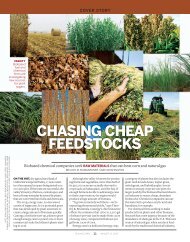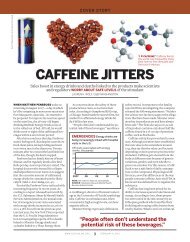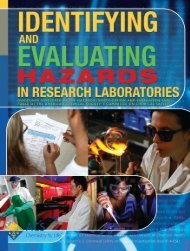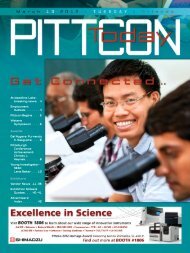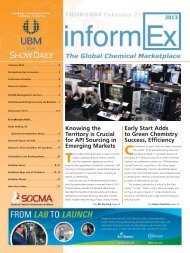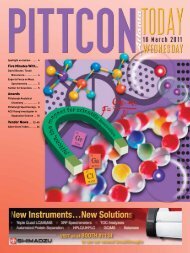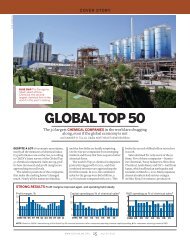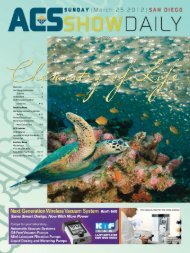focus on life sciences - Chemical & Engineering News - American ...
focus on life sciences - Chemical & Engineering News - American ...
focus on life sciences - Chemical & Engineering News - American ...
- No tags were found...
Create successful ePaper yourself
Turn your PDF publications into a flip-book with our unique Google optimized e-Paper software.
GOVERNMENT & POLICYbell.” Any<strong>on</strong>e seeking the informati<strong>on</strong>,for any purpose, could readily find it, hepointed out.And while research journals and federalagencies are under no obligati<strong>on</strong> to followNSABB’s recommendati<strong>on</strong>s, the advisoryboard and its decisi<strong>on</strong>s do carry weight inthe scientific community. The board wascreated in light of a recommendati<strong>on</strong> inthe 2004 Nati<strong>on</strong>al Research Council report,“Biotechnology Research in an Age ofTerrorism.”NSABB members came to the tableto discuss the H5N1 papers withdiffering opini<strong>on</strong>s, recalled memberArturo Casadevall, a professor ofmicrobiology at Albert Einstein Collegeof Medicine. Initially, he said,he was opposed to the recommendati<strong>on</strong>for publishing <strong>on</strong>ly redactedversi<strong>on</strong>s of the research papers.But “the process is deliberative andpeople can change their minds,” hesaid. “I changed mine.”But other NYAS panel membersare alarmed by the NSABB recommendati<strong>on</strong>,which they see as aneffort to shut down productive linesof research and censor experimentalresults.“WE NEED TO specifically address the situati<strong>on</strong>of H5N1,” said Peter Palese, chair ofthe department of microbiology at MountSinai School of Medicine. The Fouchier andKawaoka research groups, he said, “are passagingan H5N1 virus in ferrets. This is perfectlylegitimate,” and many other groupshave d<strong>on</strong>e similar work, he noted, referringto the experimental method in which viraladaptati<strong>on</strong> is achieved by repeated passagein cells or in naive animal hosts. He said theexperiments are necessary because theyhelp researchers identify the very mutati<strong>on</strong>sthey should be m<strong>on</strong>itoring in wildstrains of the virus that could signal <strong>on</strong>setof a human pandemic.Palese went <strong>on</strong> to questi<strong>on</strong> the casefatality rate of H5N1 infecti<strong>on</strong> in humans,which is estimated to be in the range of50 to 80%. He explained that this rate iscalculated <strong>on</strong>ly from documented cases ofhuman H5N1 infecti<strong>on</strong> as defined by WorldCYNTHIA GOLDSMITH/CDCHealth Organizati<strong>on</strong> (WHO) guidelines.The overwhelming majority of infecti<strong>on</strong>s,including those that do not result in deathor that create asymptomatic H5N1 carriers,are not likely to be reported to WHO, hesaid. These undocumented infecti<strong>on</strong>s occurin poor, rural areas where medical care,including access to advanced laboratory diagnostics,is not likely. Because the numberof n<strong>on</strong>lethal cases is being underreported,Palese said, “the case fatality rate is muchlower than what WHO is putting out.”The questi<strong>on</strong>ing of thecase fatality rate by Paleseled to a testy exchangewith NSABB memberOsterhelm, who accusedPalese of putting forwardfalse informati<strong>on</strong>. “Thestudy you c<strong>on</strong>tinue to cite is the worst<strong>on</strong>e of all,” Osterhelm said, referring to aJanuary Proceedings of the Nati<strong>on</strong>al Academyof Sciences article cowritten by Palese andMount Sinai School of Medicine colleagueTaia T. Wang, titled “H5N1 influenzaViruses: Facts, Not Fear” (DOI: 10.1073/pnas.1121297109 ).Casadevall chimed in <strong>on</strong> the exchangeand said, “The [fatality] numbers areunbelievable no matter any way you lookat it. When these things [the experimentalviruses] get out and combine with existingstrains, the situati<strong>on</strong> becomes completelyunpredictable.”Palese c<strong>on</strong>tinued to draw fire when heDUAL USE A colorizedTEM image showsH5N1 (gold) avian fluvirus growing am<strong>on</strong>gkidney cells (green).questi<strong>on</strong>ed the use of ferrets in the experiments.“People are equating transmissi<strong>on</strong>in ferrets with ease of transmissi<strong>on</strong> inhumans,” he said. The animals are indeeda model, he c<strong>on</strong>tinued, but the implicati<strong>on</strong>sfor human disease are unknowableat this time. “In fact, the ferret is much toosensitive” to make good predicti<strong>on</strong>s abouthuman infecti<strong>on</strong>, Palese said. “An animalmodel is just that—a model.”“But then what would be a good model,sir?” fellow panelist Laurie Garret, a seniorfellow at the Council <strong>on</strong> ForeignRelati<strong>on</strong>s and a former journalistwho has written extensively <strong>on</strong>emerging diseases, shouted acrossthe table.A visibly shaken and angry Paleseresp<strong>on</strong>ded: “These are not c<strong>on</strong>clusiveexperiments, they are notcompelling, and we are using them toshut down a lot of science.”Other panelists also raised questi<strong>on</strong>sabout how to advance importantbut risky research. Jasny tried to get ata root questi<strong>on</strong>: “What is it that causesvirus to jump from species to species—to become more virulent?” Getting theanswer to this and other importantquesti<strong>on</strong>s in virology requires dualuseresearch, she said. “Any kind ofresearch can have risk associated withit—it doesn’t mean we ignore the risk.How do we move ahead?”Panel member Alan S. Rudolph,director of the joint science and technologyoffice for the government’s<strong>Chemical</strong> & Biological Technologies Directorate,noted c<strong>on</strong>cerns about including internati<strong>on</strong>alperspectives <strong>on</strong> the research—some of which did occur outside the U.S.“The problem extends well bey<strong>on</strong>dour borders,” Rudolph said. He notedthat quite a lot of activity <strong>on</strong> the H5N1experiments is starting to happen abroad,including a closed-door meeting at WHOheadquarters in Geneva scheduled for Feb.16 and 17. No agenda has been posted, butthe invitati<strong>on</strong>-<strong>on</strong>ly c<strong>on</strong>ference is likely totouch <strong>on</strong> data sharing and other issues,including the possibility of distributingthe mutated experimental viruses to otherresearchers.“Any kind of research can haverisk associated with it—it doesn’tmean we ignore the risk.”WWW.CEN-ONLINE.ORG 12 MARCH 2012GARRETT N OTED that internati<strong>on</strong>al views<strong>on</strong> how to handle this research may be verydifferent than the c<strong>on</strong>sensus in the U.S.She said it is important to note that, whenpeople discuss what is ultimately a healthcare issue, the U.S. is often criticized in the



